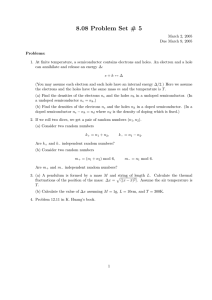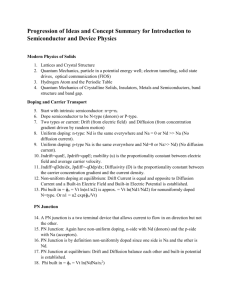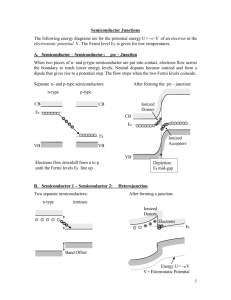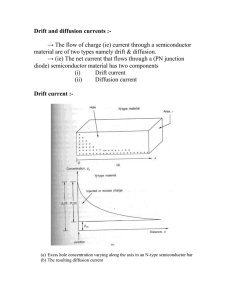1.1.1 Drift and Diffusion Currents We`ve described
advertisement
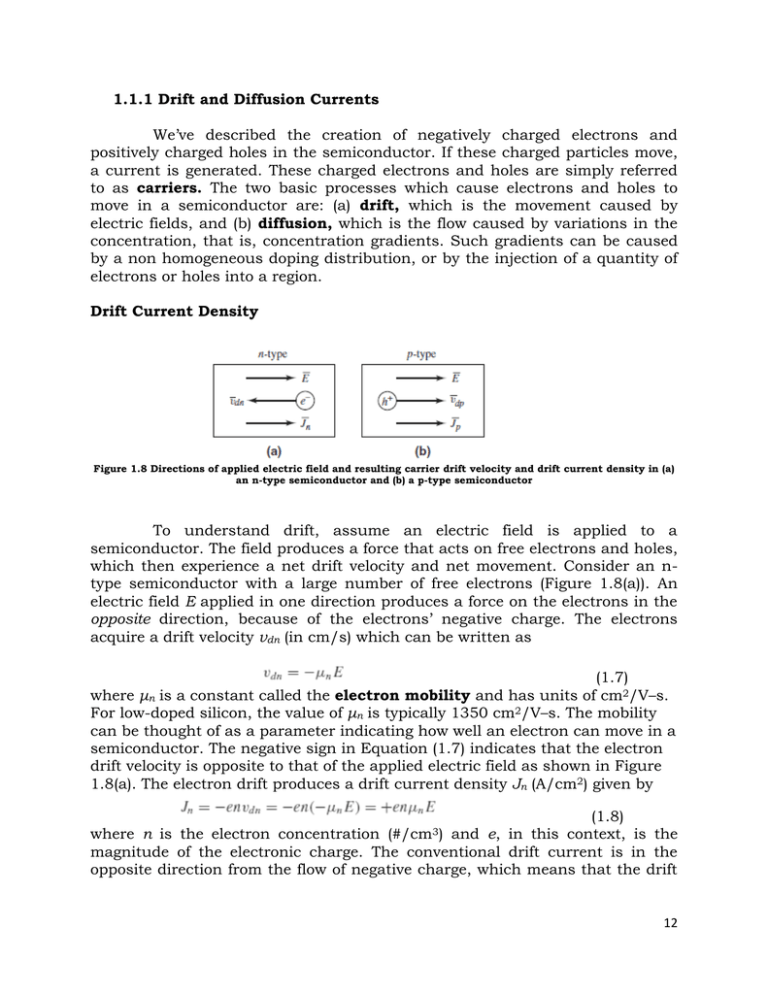
1.1.1 Drift and Diffusion Currents We’ve described the creation of negatively charged electrons and positively charged holes in the semiconductor. If these charged particles move, a current is generated. These charged electrons and holes are simply referred to as carriers. The two basic processes which cause electrons and holes to move in a semiconductor are: (a) drift, which is the movement caused by electric fields, and (b) diffusion, which is the flow caused by variations in the concentration, that is, concentration gradients. Such gradients can be caused by a non homogeneous doping distribution, or by the injection of a quantity of electrons or holes into a region. Drift Current Density Figure 1.8 Directions of applied electric field and resulting carrier drift velocity and drift current density in (a) an n-type semiconductor and (b) a p-type semiconductor To understand drift, assume an electric field is applied to a semiconductor. The field produces a force that acts on free electrons and holes, which then experience a net drift velocity and net movement. Consider an ntype semiconductor with a large number of free electrons (Figure 1.8(a)). An electric field E applied in one direction produces a force on the electrons in the opposite direction, because of the electrons’ negative charge. The electrons acquire a drift velocity vdn (in cm/s) which can be written as (1.7) where μn is a constant called the electron mobility and has units of cm2/V–s. For low-doped silicon, the value of μn is typically 1350 cm2/V–s. The mobility can be thought of as a parameter indicating how well an electron can move in a semiconductor. The negative sign in Equation (1.7) indicates that the electron drift velocity is opposite to that of the applied electric field as shown in Figure 1.8(a). The electron drift produces a drift current density Jn (A/cm2) given by (1.8) where n is the electron concentration and e, in this context, is the magnitude of the electronic charge. The conventional drift current is in the opposite direction from the flow of negative charge, which means that the drift (#/cm3) 12 current in an n-type semiconductor is in the same direction as the applied electric field. Next consider a p-type semiconductor with a large number of holes (Figure l.8(b)). An electric field E applied in one direction produces a force on the holes in the same direction, because of the positive charge on the holes. The holes acquire a drift velocity vdp (in cm/s), which can be written as (1.9) where μp is a constant called the hole mobility, and again has units of cm2/V– s. For low-doped silicon, the value of μp is typically 480 cm2/V–s, which is less than half the value of the electron mobility. The positive sign in Equation (1.9) indicates that the hole drift velocity is in the same direction as the applied electric field as shown in Figure 1.8(b). The hole drift produces a drift current density Jp (A/cm2) given by (1.10) where p is the hole concentration (#/cm3) and e is again the magnitude of the electronic charge. The conventional drift current is in the same direction as the flow of positive charge, which means that the drift current in a p-type material is also in the same direction as the applied electric field. Since a semiconductor contains both electrons and holes, the total drift current density is the sum of the electron and hole components. The total drift current density is then written as (1.11.a) where (1.11.b) and where σ is the conductivity of the semiconductor in and where ρ = 1/σ is the resistivity of the semiconductor in (Ω–cm). The conductivity is related to the concentration of electrons and holes. If the electric field is the result of applying a voltage to the semiconductor, then Equation (1.11(a)) becomes a linear relationship between current and voltage and is one form of Ohm’s law. From Equation (1.11(b)), we see that the conductivity can be changed from strongly n-type, n p, by donor impurity doping to strongly p-type, p n, by acceptor impurity doping. Being able to control the conductivity of a semiconductor by selective doping is what enables us to fabricate the variety of electronic devices that are available. (Ω–cm)−1 13 Example 1.3 Calculate the drift current density for a given semiconductor. Consider silicon at T = 300 K doped with arsenic atoms at a concentration of Nd = 8 × 1015 cm−3 . Assume mobility values of μn = 1350 cm2/V–s and μp = 480 cm2/V–s. Assume the applied electric field is 100 V/cm. The electron and hole concentrations are and Because of the difference in magnitudes between the two concentrations, the conductivity is given by or Then the drift current density is Comment: Since n _ p, the conductivity is essentially a function of the electron concentration and mobility only. We may note that a current density of a few hundred amperes per square centimeter can be generated in a semiconductor. Exercise 1.3 Consider n-type GaAs at T = 300 K doped to a concentration of Nd = 2 × 1016 cm−3 . Assume mobility values of μn = 6800 cm2/V–s and μp = 300 cm2/V–s. (a) Determine the resistivity of the material. (b) Determine the applied electric field that will induce a drift current density of 175 A/cm2. (Ans. (a) 0.0460 Ω–cm, (b) 8.04 V/cm). Note: Two factors need to be mentioned concerning drift velocity and mobility. Equations (1.7) and (1.9) imply that the carrier drift velocities are linear functions of the applied electric field. This is true for relatively small electric fields. As the electric field increases, the carrier drift velocities will reach a maximum value of approximately 10 7 cm/s. Any further increase in electric field will not produce an increase in drift velocity. This phenomenon is called drift velocity saturation. Electron and hole mobility values were given in Example 1.3. The mobility values are actually functions of donor and/or acceptor impurity concentrations. As the impurity concentration increases, the mobility values will decrease. This effect then means that the conductivity, Equation (1.11(b)), is not a linear function of impurity doping. These two factors are important in the design of semiconductor devices, but will not be considered in detail in this text. 14 Diffusion Current Density In the diffusion process, particles flow from a region of high concentration to a region of lower concentration. This is a statistical phenomenon related to kinetic theory. To explain, the electrons and holes in a semiconductor are in continuous motion, with an average speed determined by the temperature, and with the directions randomized by interactions with the lattice atoms. Statistically, we can assume that, at any particular instant, approximately half of the particles in the high-concentration region are moving away from that region toward the lower-concentration region. We can also assume that, at the same time, approximately half of the particles in the lower concentration region are moving toward the high-concentration region. However, by definition, there are fewer particles in the lower-concentration region than there are in the high-concentration region. Therefore, the net result is a flow of particles away from the high-concentration region and toward the lower concentration region. This is the basic diffusion process. Figure 1.9 (a) Assumed electron concentration versus distance in a semiconductor, and the resulting electron diffusion and electron diffusion current density, (b) assumed hole concentration versus distance in a semiconductor, and the resulting hole diffusion and hole diffusion current density. For example, consider an electron concentration that varies as a function of distance x, as shown in Figure 1.9(a). The diffusion of electrons from a high-concentration region to a low-concentration region produces a flow of electrons in the negative x direction. Since electrons are negatively charged, the conventional current direction is in the positive x direction. The diffusion current density due to the diffusion of electrons can be written as (for one dimension) (1.12) where e, in this context, is the magnitude of the electronic charge, dn/dx is the gradient of the electron concentration, and Dn is the electron diffusion coefficient. 15 In Figure 1.9(b), the hole concentration is a function of distance. The diffusion of holes from a high-concentration region to a low-concentration region produces a flow of holes in the negative x direction. (Conventional current is in the direction of the flow of positive charge.) The diffusion current density due to the diffusion of holes can be written as (for one dimension) (1.13) where e is still the magnitude of the electronic charge, dp/dx is the gradient of the hole concentration, and Dp is the hole diffusion coefficient. Note the change in sign between the two diffusion current equations. This change in sign is due to the difference in sign of the electronic charge between the negatively charged electron and the positively charged hole. Example 1.4 Calculate the diffusion current density for a given semiconductor. Consider silicon at T = 300 K. Assume the electron concentration varies linearly from n = 1012 cm−3 to n = 1016 cm−3 over the distance from x = 0 to x = 3 μm. Assume Dn = 35 cm2/s. We have or Comment: Diffusion current densities on the order of a few hundred amperes per square centimeter can also be generated in a semiconductor. Exercise 1.4 Consider silicon at T = 300 K. Assume the hole concentration is given by p = 1016e−x/Lp (cm−3), where Lp = 10−3 cm. Calculate the hole diffusion current density at (a) x = 0 and (b) x = 10−3cm. Assume Dp = 10 cm2/s. (Ans. (a) 16 A/cm2, (b) 5.89 A/cm2) The mobility values in the drift current equations and the diffusion coefficient values in the diffusion current equations are not independent quantities. They are related by the Einstein relation, which is (1.14) 16 at room temperature. The total current density is the sum of the drift and diffusion components. Fortunately, in most cases only one component dominates the current at any one time in a given region of a semiconductor. Design Pointer In the previous two examples, current densities on the order of 200 A/cm2 have been calculated. This implies that if a current of 1 mA, for example, is required in a semiconductor device, the size of the device is small. The total current is given by I = JA, where A is the cross-sectional area. For I = 1 mA = 1 × 10−3 A and J = 200 A/cm2, the cross-sectional area is A = 5 × 10−6 cm2. This simple calculation again shows why semiconductor devices are small in size. 1.14 Excess Carriers Up to this point, we have assumed that the semiconductor is in thermal equilibrium. In the discussion of drift and diffusion currents, we implicitly assumed that equilibrium was not significantly disturbed. Yet, when a voltage is applied to, or a current exists in, a semiconductor device, the semiconductor is really not in equilibrium. In this section, we will discuss the behavior of non equilibrium electron and hole concentrations. Valence electrons may acquire sufficient energy to break the covalent bond and become free electrons if they interact with high-energy photons incident on the semiconductor. When this occurs, both an electron and a hole are produced, thus generating an electron–hole pair. These additional electrons and holes are called excess electrons and excess holes. When these excess electrons and holes are created, the concentrations of free electrons and holes increase above their thermal equilibrium values. This may be represented by (1.15a) and (1.15b) where no and po are the thermal equilibrium concentrations of electrons and holes, and δn and δp are the excess electron and hole concentrations. If the semiconductor is in a steady-state condition, the creation of excess electrons and holes will not cause the carrier concentration to increase indefinitely, because a free electron may recombine with a hole, in a process called electron–hole recombination. Both the free electron and the hole disappear causing the excess concentration to reach a steady-state value. The mean time over which an excess electron and hole exist before recombination is called the excess carrier lifetime. 17 1.2 The pn Junction In the preceding sections, we looked at characteristics of semiconductor materials. The real power of semiconductor electronics occurs when p- and n-regions are directly adjacent to each other, forming a pn junction. One important concept to remember is that in most integrated circuit applications, the entire semiconductor material is a single crystal, with one region doped to be p-type and the adjacent region doped to be n-type. 1.2.1 The Equilibrium pn Junction Figure 1.10 (a) The pn junction: (a) simplified one-dimensional geometry, (b) doping profile of an ideal uniformly doped pn junction, and (c) three-dimensional representation showing the cross-sectional area Figure 1.10(a) is a simplified block diagram of a pn junction. Figure 1.10(b) shows the respective p-type and n-type doping concentrations, assuming uniform doping in each region, as well as the minority carrier concentrations in each region, assuming thermal equilibrium. Figure 1.10(c) is a three dimensional diagram of the pn junction showing the cross-sectional area of the device. The interface at x = 0 is called the metallurgical junction. A large density gradient in both the hole and electron concentrations occurs across this junction. Initially, then, there is a diffusion of holes from the pregion into the n-region, and a diffusion of electrons from the n-region into the p-region (Figure 1.11). The flow of holes from the p-region uncovers negatively charged acceptor ions, and the flow of electrons from the n-region uncovers positively charged donor ions. This action creates a charge separation (Figure 1.12(a)), which sets up an electric field oriented in the direction from the positive charge to the negative charge. Figure 1.11 Initial diffusion of electrons and holes across the metallurgical junction at the “instant in time” that the p- and n-regions are joined together 18 Figure 1.12 The pn junction in thermal equilibrium. (a) The space charge region with negatively charged acceptor ions in the p-region and positively charged donor ions in the n-region; the resulting electric field from the n- to the p-region. (b) The potential through the junction and the built-in potential barrier Vbi across the junction. If no voltage is applied to the pn junction, the diffusion of holes and electrons must eventually cease. The direction of the induced electric field will cause the resulting force to repel the diffusion of holes from the p-region and the diffusion of electrons from the n-region. Thermal equilibrium occurs when the force produced by the electric field and the “force” produced by the density gradient exactly balance. The positively charged region and the negatively charged region comprise the space-charge region, or depletion region, of the pn junction, in which there are essentially no mobile electrons or holes. Because of the electric field in the space charge region, there is a potential difference across that region (Figure 1.12(b)). This potential difference is called the built-in potential barrier, or built-in voltage, and is given by (1.16) where VT ≡ kT/e, k = Boltzmann’s constant, T = absolute temperature, e = the magnitude of the electronic charge, and Na and Nd are the net acceptor and donor concentrations in the p- and n-regions, respectively. The parameter VT is called the thermal voltage and is approximately VT = 0.026 V at room temperature, T = 300 K. Example 1.5 Calculate the built-in potential barrier of a pn junction. Consider a silicon pn junction at T = 300 K, doped at Na = 1016 cm−3 in the pregion and Nd = 1017cm−3 in the n-region. 19 From the results of Example 1.1, we have ni = 1.5 × 1010cm−3 for silicon at room temperature. We then find Comment: Because of the log function, the magnitude of Vbi is not a strong function of the doping concentrations. Therefore, the value of Vbi for silicon pn junctions is usually within 0.1 to 0.2 V of this calculated value. Exercise 1.5 (a) Calculate Vbi for a GaAs pn junction at T = 300 K for Na = 1016 cm−3 and Nd = 1017 cm−3 (b) Repeat part (a) for a Germanium pn junction with the same doping concentrations. (Ans. (a) Vbi = 1.23 V, (b) Vbi = 0.374 V). The potential difference, or built-in potential barrier, across the spacecharge region cannot be measured by a voltmeter because new potential barriers form between the probes of the voltmeter and the semiconductor, canceling the effects of Vbi . In essence, Vbi maintains equilibrium, so no current is produced by this voltage. However, the magnitude of Vbi becomes important when we apply a forward-bias voltage. 1.2.2 Reverse-Biased pn Junction Assume a positive voltage is applied to the n-region of a pn junction, as shown in Figure 1.13. The applied voltage VR induces an applied electric field, EA, in the semiconductor. The direction of this applied field is the same as that of the E-field in the space-charge region. The magnitude of the electric field in the space-charge region increases above the thermal equilibrium value. This increased electric field holds back the holes in the p-region and the electrons in the n-region, so there is essentially no current across the pn junction. By definition, this applied voltage polarity is called reverse bias. Figure 1.13 A pn junction with an applied reverse-bias voltage, showing the direction of the electric field induced by VR and the direction of the original space-charge electric field. Both electric fields are in the same direction, resulting in a larger net electric field and a larger barrier between the p- and n-regions. 20 When the electric field in the space-charge region increases, the number of positive and negative charges must increase. If the doping concentrations are not changed, the increase in the fixed charge can only occur if the width W of the space-charge region increases. Therefore, with an increasing reverse-bias voltage VR, space-charge width W also increases. This effect is shown in Figure 1.14. Figure 1.14 Increase in space-charge width with an increase in reverse bias voltage from VR to VR + VR . Creation of additional charges + Q and − Q leads to a junction capacitance. Because of the additional positive and negative charges induced in the space-charge region with an increase in reverse-bias voltage, a capacitance is associated with the pn junction when a reverse-bias voltage is applied. This junction capacitance, or depletion layer capacitance, can be written in the form (1.17) where Cjo is the junction capacitance at zero applied voltage. The junction capacitance will affect the switching characteristics of the pn junction, as we will see later in the chapter. The voltage across a capacitance cannot change instantaneously, so changes in voltages in circuits containing pn junctions will not occur instantaneously. Note: The capacitance–voltage characteristics can make the pn junction useful for electrically tunable resonant circuits. Junctions fabricated specifically for this purpose are called varactor diodes. Varactor diodes can be used in electrically tunable oscillators, such as a Hartley oscillator. Example 1.6 Calculate the junction capacitance of a pn junction. Consider a silicon pn junction at T = 300 K, with doping concentrations of Na = 1016 cm−3 and Nd = 1015 cm−3. Assume that ni = 1.5 × 1010 cm−3 and let Cjo = 0.5 pF. Calculate the junction capacitance at VR = 1V and VR = 5V. 21 The built-in potential is determined by Comment: The magnitude of the junction capacitance is usually at or below the pico farad range, and it decreases as the reverse-bias voltage increases. Exercise 1.6 A silicon pn junction at T = 300 K is doped at Nd = 1016 cm−3 and Na = 1017 cm−3. The junction capacitance is to be Cj = 0.8pF when a reverse bias voltage of VR = 5V is applied. Find the zero-biased junction capacitance Cjo. (Ans. Cjo = 2.21 pF) As implied in the previous section, the magnitude of the electric field in the spacecharge region increases as the reverse-bias voltage increases, and the maximum electric field occurs at the metallurgical junction. However, neither the electric field in the space-charge region nor the applied reverse-bias voltage can increase indefinitely because at some point, breakdown will occur and a large reverse bias current will be generated. 1.2.3 Forward-Biased pn Junction We have seen that the n-region contains many more free electrons than the pregion; similarly, the p-region contains many more holes than the n-region. With zero applied voltage, the built-in potential barrier prevents these majority carriers from diffusing across the space-charge region; thus, the barrier maintains equilibrium between the carrier distributions on either side of the pn junction. Figure 1.15 A pn junction with an applied forward-bias voltage showing the direction of the electric field induced by VD and the direction of the original space-charge electric field. The two electric fields are in opposite directions resulting in a smaller net electric field and a smaller barrier between the p- and n-regions. The net electric field is always from the n- to the p-region. 22 If a positive voltage vD is applied to the p-region, the potential barrier decreases (Figure 1.15). The electric fields in the space-charge region are very large compared to those in the remainder of the p- and n-regions, so essentially all of the applied voltage exists across the pn junction region. The applied electric field, EA, induced by the applied voltage is in the opposite direction from that of the thermal equilibrium space-charge E-field. However, the net electric field is always from the n- to the p-region. The net result is that the electric field in the space-charge region is lower than the equilibrium value. This upsets the delicate balance between diffusion and the E-field force. Majority carrier electrons from the n-region diffuse into the p-region, and majority carrier holes from the p-region diffuse into the n-region. The process continues as long as the voltage vD is applied, thus creating a current in the pn junction. This process would be analogous to lowering a dam wall slightly. A slight drop in the wall height can send a large amount of water (current) over the barrier. This applied voltage polarity (i.e., bias) is known as forward bias. The forward bias voltage vD must always be less than the built-in potential barrier Vbi. As the majority carriers cross into the opposite regions, they become minority carriers in those regions, causing the minority carrier concentrations to increase. Figure 1.16 shows the resulting excess minority carrier concentrations at the space-charge region edges. These excess minority carriers diffuse into the neutral n- and p-regions, where they recombine with majority carriers, thus establishing a steady state condition, as shown in Figure 1.16. Figure 1.16 Steady-state minority carrier concentrations in a pn junction under forward bias. The gradients in the minority carrier concentrations generate diffusion currents in the device. 1.2.4 Ideal Current–Voltage Relationship As shown in Figure 1.16, an applied voltage results in a gradient in the minority carrier concentrations, which in turn causes diffusion currents. The theoretical relationship between the voltage and the current in the pn junction is given by 23 (1.18) The parameter IS is the reverse-bias saturation current. For silicon pn junctions, typical values of IS are in the range of 10−18 to 10−12 A. The actual value depends on the doping concentrations and is also proportional to the cross-sectional area of the junction. The parameter VT is the thermal voltage, as defined in Equation (1.16), and is approximately VT = 0.026 V at room temperature. The parameter n is usually called the emission coefficient or ideality factor, and its value is in the range 1 ≤ n ≤ 2. The emission coefficient n takes into account any recombination of electrons and holes in the space-charge region. At very low current levels, recombination may be a significant factor and the value of n may be close to 2. At higher current levels, recombination is less a factor, and the value of n will be 1. Unless otherwise stated, we will assume the emission coefficient is n = 1. This pn junction, with nonlinear rectifying current characteristics, is called a pn junction diode. Example 1.7 Determine the current in a pn junction diode. Consider a pn junction at T = 300 K in which IS = 10−14 A and n = 1. Find the diode current for vD = +0.70 V and vD = −0.70 V. For vD = +0.70 V, the pn junction is forward-biased and we find Comment: Although IS is quite small, even a relatively small value of forwardbias voltage can induce a moderate junction current. With a reverse-bias voltage applied, the junction current is virtually zero. Exercise 1.7 (a) A silicon pn junction at T = 300 K has a reverse-saturation current of IS = 2 × 10−14 A. Determine the required forward-bias voltage to produce a current of (i) ID = 50 μA and (ii) ID = 1 mA. (b) Repeat part (a) for IS = 2 × 10−12 A. (Ans. (a) (i) 0.563 V, (ii) 0.641 V; (b) (i) 0.443 V, (ii) 0.521 V). 24


